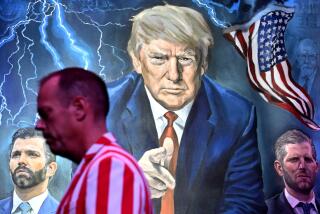A Victim of the Third Great Awakening
- Share via
AMAGANSETT, N.Y. — As retrospectives of the Clinton administration begin stacking up and its achievements are tallied, we are hearing about America’s unprecedented prosperity, about the balanced budget and future surpluses, about reform of the welfare system, about peacekeeping missions to Bosnia and Kosovo, and peacemaking efforts in Northern Ireland, and about the preservation of wilderness areas. We are hearing, too, about the ways in which Bill Clinton revived his moribund party by moving it to the center of the political spectrum and about how he helped redefine American expectations from bold initiatives, like his failed 1993-94 health-care reform plan, to incrementalism. We even hear about a new spirit of tolerance that the president promoted, making it more difficult for his successors to exploit the old buzzwords of racial and sexual prejudice.
Despite these accomplishments, though, Clinton is likely to be remembered, first and foremost, as only the second president to be impeached and tried. The scarlet letter “I” is emblazoned perma- nently on his record, and it will almost certainly define his presidency not only for those of us who lived through it, but for those who will study it in the future. Looking at a larger context, these future historians will probably see Clinton’s impeachment and trial as one of the major battles in an ongoing cultural war, and Clinton himself as the whipping boy of America’s Third Great Awakening, a powerful religious revival that swept through the nation during the Clinton years and that decisively reshaped the political landscape.
The First Great Awakening occurred in British America between roughly 1720 and 1750. Originating in the Middle Colonies, then spreading north to New England, the Awakening was a series of revivals intended to reawaken the flock to Christ at a time when religious belief was withering under the assault of Enlightenment rationalism. Great revivalists like George Whitefield, who had to preach in fields because no church could accommodate the crowds he drew, and Jonathan Edwards, who managed to breathe hellfire into tightly argued sermons, stoked the religious blazes. While stressing God’s implacable wrath against transgressors, they offered salvation to anyone who acknowledged sinfulness and professed to accept Jesus as savior. The result was a reinvigorated American Christianity.
A Second Great Awakening flared some 50 years later and lasted into the 1830s, this one originating in New England but rapidly spreading across the American frontier through traveling preachers. Though it, too, was devoted to reviving religious feeling and emphasized personal conversion, it had a different, less strident tone from the earlier revival. As one historian characterized them, the First Great Awakening was a “First Commandment” movement, predicated on the unassailable authority of God and engendering fear, while the Second was a “Second Commandment” movement, predicated on the singularity of God and engendering love.
It would be a long time before America experienced another comparable religious enthusiasm. While one can argue that the Social Gospel campaign of the late 19th century, spearheaded by evangelist Dwight L. Moody, and the revivalism of the 1920s, featuring luminaries like Billy Sunday and Aimee Semple McPherson, qualified as Great Awakenings, these were relatively brief religious eruptions with little cohesion or lasting effect. It wasn’t until the 1980s, with the rise of the Christian right, that a sustained and powerful religious crusade worthy of being called an Awakening took hold--a crusade that continues to this day.
Like its predecessors, the Third Great Awakening is an effort to reignite religious fervor. From the Southern pulpits and television broadcasts where it was launched, it seeks to stem creeping secularism and the moral dissolution that it says accompanies secularism by stressing the same sorts of imprecations that Edwards had: the inherent sinfulness of man, the eternal damnation of sinners, the need for God’s restraints in a world of temptation and transgression. While allowance is made for salvation through conversion--what was called “the winning of souls” during the Second Great Awakening--the core movement, in truth, seems more interested in attacking miscreants than in saving them. In some ways, this is the “Sixth through Tenth” Commandments Awakening, fastening less on one’s obligations to the Lord than on prohibitions of behavior. These Third Great Awakeners are comfortable with Edwards’ indictment in his famous sermon, “Sinners in the Hands of an Angry God”: “They deserve to be cast into Hell. . . . Yea . . . justice calls aloud for an infinite punishment of their sins.”
But if the first two Great Awakenings were religiously inspired, they also had deep political implications. The religious passions that fed the revivals of the mid-18th century were transmuted into political passion for American independence from England and its--including religious--institutions. It is even possible that without this sense of religious democratization through personal conversion, the colonists might not have been emboldened to challenge England. Similarly, the focus of the Second Great Awakening on winning souls and living a religious life would be transmuted into the temperance movement, abolitionism and women’s rights--a search for religious perfection becoming political action.
The Third Great Awakening takes its political mission even more seriously and aims it more directly at its enemies. While it began by organizing ad hoc campaigns against everything from the teaching of evolution to a woman’s right to an abortion, it empowered itself by sending its Christian soldiers onward into the Republican Party, commandeering it through money and grass-roots mobilization until no prospective Republican presidential candidate could think of being nominated without its endorsement. In effect, what the Third Great Awakeners did in taking over the GOP was convert one of America’s two major parties from a political organization dedicated to effecting policy, as parties traditionally did, into one that was also dedicated to eradicating sin, which is an entirely new function.
Like the 18th-century colonies, 20th-century America seemed to be awash in sin. It wallowed in what Awakeners regarded as a vulgar popular culture, promiscuous sexual mores, recreational drugs and other forms of licentiousness. The Third Awakeners are determined to stop this descent not just through moral suasion, like their forebears, or even through social action but through government action. Indeed, the transformation of the Republican Party into a religious instrument is very likely the biggest political story of our time and one of the biggest cultural ones, too.
Still, none of this really mattered much as long as Ronald Reagan and George Bush were in power. As Republicans, they had to pay tribute to the new Awakeners and promise to promote their agenda, which they did. Clinton, however, was another matter. Clinton could have been secularism’s poster child. Long before Americans heard of Monica S. Lewinsky, he was the personification of everything the Awakeners detested, everything they believed was leading the country astray, and virtually from the moment of his election, the Awakeners disputed his legitimacy as president, putting their newfound political muscle behind their moral disapprobation.
When it came to dreaded rationalism, Clinton was a bona fide intellectual with a Yale law degree and a Rhodes scholarship. When it came to moral ardor, he was a temporizer who preached moderation, while the Awakeners were preaching absolutism. When it came to worldliness, he liked to hobnob with a Hollywood elite that was accused of corrupting America’s soul, while the Awakeners preferred their own parochialism. When it came to a devout life, Clinton was a self-indulgent baby boomer, while the Awakeners were, theoretically at least, abstemious. Moreover, he was wrong on abortion, wrong on acceptance of gays, wrong on taxes, wrong on conservation. Wrong on everything.
When Clinton’s dalliance with Lewinsky was revealed, the Awakeners bagged their sinner and could subject him to ritual damnation. They made him, in Edwards’ words, the object of the “very same anger and wrath of God that is expressed in the torments of hell.” If Clinton was the symbol of secular evil, his “torments of hell,” namely impeachment and trial, would help rescue the nation. Punishing him would be purgative, literally and figuratively. Thus was the Clinton presidency turned into a struggle between the forces of cultural secularism and moral religiosity. Impeachment was to be the Armageddon.
It didn’t turn out that way. Instead, the war continued right through the last election and into the U.S. Supreme Court, where the Awakeners found a way to change their moralisms into legalisms. But history takes a longer view. History is likely to condemn Clinton for being undisciplined--and foolish--enough to have misbehaved in a way that confirmed the Awakeners’ direst warnings of moral decline. But, depending on who writes the history, his survival in office against great odds is also likely to be viewed either as an important test for American democracy when confronted by fanatical theocrats or as proof of the ineluctability of decadence in a modern society. Whichever he becomes, champion of secular tolerance or symbol of immorality, Clinton will almost certainly be defined by his relationship to the Third Great Awakening, rather than by the very real achievements of his administration. For better or worse, that is his place in history.


